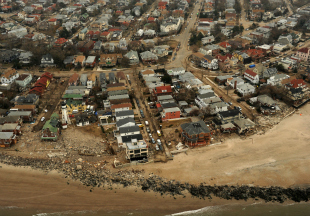

As winter approaches, construction crews in New York are in a race against the clock to make thousands of houses damaged by Superstorm Sandy habitable again, and the slow pace of progress has led some people to urge officials to bring in campers or mobile homes as a stopgap solution.
Thousands of residents along the New York and New Jersey coastlines still lack power and heat after the October storm and a tidal surge turned basement furnaces and electrical panels into worthless junk.
In New York City and Long Island, the Federal Emergency Management Agency and municipal officials have tried a new approach to getting basic utilities to those homes restored quickly: a $500 million program called “rapid repair.” More than 2,000 workers have been sent into flood-damaged neighborhoods to get home heating systems back on line, plug holes in roofs and walls, and restore electrical hookups. All the work is being done for free.

The program has been building steam lately, but with seven weeks elapsed since the Oct. 29 storm, there is still so much work left to do, prompting some to call on FEMA to bring in temporary housing — a solution that has been repeatedly rejected by officials as unworkable in New York.
As of last Friday, 60 percent of the more than 13,600 New Yorkers who had applied for help from the repair program were still waiting for the work on their homes to begin. Work has been completed on 2,625 homes. Repairs were in progress on another 2,800, according to the city. Those numbers represented a big improvement from the first week in December, when only around 400 projects had been completed.
“I think the trend, right now, is headed in the right direction,” said Michael Byrne, the FEMA official supervising Superstorm Sandy recovery in New York.
But the likelihood that some people would still be waiting for repair work in the icy chill of January has also prompted concern, and some anger.
Activists affiliated with the “Occupy” movement were planning demonstrations at Mayor Michael Bloomberg’s home and locations on the Rockaway Peninsula and Staten Island, calling for FEMA to activate the trailer program in New York. A town hall style meeting in Staten Island recently drew hundreds of residents, including some who loudly called for trailers to be brought in.
Other groups have sought other relief. A group of clergy in Queens led a meeting of hundreds of Rockaway residents last week, calling on the city to add mold remediation to the rapid repair program and ease red tape for contractors hailing from outside New York who wish to get involved in the program.
“We are seeing a ton of homes where people are sitting in them without heat, hot water and electricity, and mold is just growing in them,” said Joseph McKellar, executive director of the group Queens Congregations United for Action.
Bringing in trailers is an option that both FEMA and Bloomberg have said could be a disaster.
The winterized mobile homes in FEMA’s fleet are meant for trailer parks, where they can sit on cement slabs and be easily connected to water, sewer, electrical and natural gas utilities. No such sites exist in New York City, and while there is available parkland where trailer parks could be constructed, doing so would be expensive, involve laying sewer and gas lines and could take two to three months, Byrne said.
“If people are interested in relocating up to Orange County, we could find sites like that,” Byrne said. “But I don’t think that’s what New Yorkers want.”
FEMA no longer uses the small, camper-like trailers that were abundant in New Orleans after Hurricane Katrina after they were widely criticized as unfit living arrangements. Asked about FEMA trailers, Bloomberg said he would rather get people back in their own homes.
“That’s where our focus is,” he said. “And trailers, if you take a look at what the experience was in New Orleans, it was not good. They had formaldehyde problems. They couldn’t get rid of them. Everybody disliked them. It was a very big problem.”
FEMA has been putting 2,000 New Yorkers with uninhabitable homes up in hotels.
In the meantime, some homeowners, like Rockaway resident Valerie Close, have turned to the private sector to get repairs done. That route hasn’t been easy either.
Close, whose house still lacks heat or hot water, had trouble finding an electrician and only got her power back on this week. She still hasn’t found a contractor to fix her boiler.
“We called one company, and they said they didn’t have any appointments to fix it for a month-and-a-half,” she said. “It’s just become a really ugly situation.”